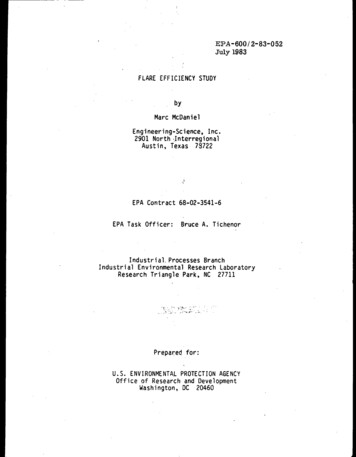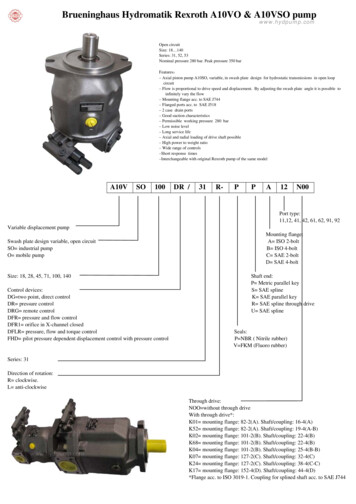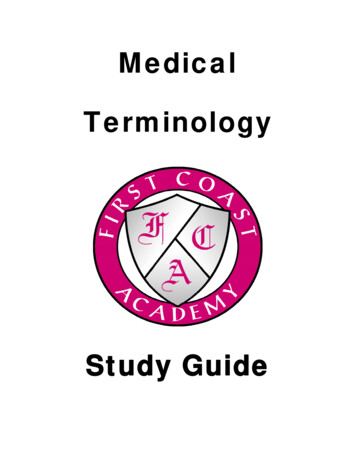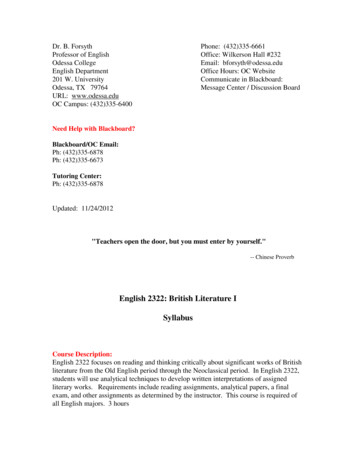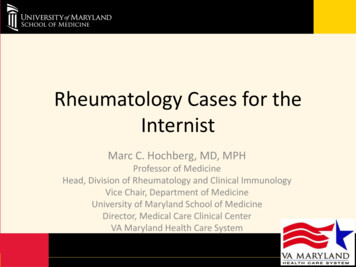
Transcription
I 1.011.19, 19351JAN.JAN HE BRITISTIMTMEDICAL JOURNALONE HUNDRED AND THIRD ANNUAL MEETINGof theBritishMedicalAss-ociationMELBOURNE, 1935JHE British Medical Association will hold its 103rd Annual Meeting in M\elbourne, Australia, during theweek beginning September 9th, 1935, under the p-esideracy of Sir Richard Stawell, K.B.E., 1L.D., consulting physician to the Melbourne Hospital. The Sectional sessions for scientific and clinical work will beheld on Wednesday, Thursday, and Friday, Septemb2r 11th, 12th, and 13th. The Annual RepresentativeMeeting for the transactiQn of medico-political business will take place in London at the Association's Houseon Friday, July 19th, and following days.Members travelling to Australia through the United States will sail for New York from Southampton onSaturday, July 27th ; if travelling by the Canadian route to San Francisco, they will sail for Montreal fromLiverpool on July 26th, or from Glasgow on July 27th. Particulars of the two routes were given in ourSupplement of March 10th, 1934. -All arrangements for the journey are in the hands of the Financial Secretaryand Business Manager, B.M.A. House, Tavistock Square, London, W.C.1, to whom early application shouldbe made for reservation of places on steamers and trains and at hotels. Members who cannot afford tobe away for the whole time of the " round-the-world " tour may leave London on August 8th, travellingoverland to Toulon and embarking there on a P. & 0. liner which arrives at Fremantle on September 3rd.The journey on to Melbourne takes three days by rail, so that those who follow this route will reach theirdestination three days before the meeting opens.The honorary local general secretary for this year's Annual Meeting is Dr. J. P. Major, Medical SocietyHall, East Melbourne, Victoria. The names of the officers of the fourteen Scientific Sections were given inthe Supplement of December 8th, 1934 ; and further information, with provisional programmes, etc., willappear in subsequent issues. We publish below the third of a series of descriptive and historical articleson the city of Melbourne and its medical institutions; the first appeared on October 20th (p. 730), and thesecond on December 8th (p. 1050).THE SETTING OF A CITYBYR. H. CROLLAuthor of " The Open Road in Victoria " and " Alongthe Track"Melbourne ranks as the seventh city of the Empire. Yetshe still leans back from her long bay frontages uponforest (" the Bush " in Australian parlance), some ofwhich has been so litt'e altered by the white invasionthat what our fathers came to a hundred years ago mayreadily be visioned. Her eastward outlook is to theDandenongs, a blue range about twenty miles away, andthere, thanks to the reserves so thoughtfully created bythe pioneers, are areas of scrub, shrub, and tree in almosttheir primal state."The Bush" in VictoriaThe gum tree, as the eucalyptus is commonly called,challenges the famous American redwoods in size. Inthe Dandenongs the cool green stems, unbroken by abranch for perhaps a hundred feet, rise from a denseundergrowth of fern, hazel, wattle, and musk, shrubs-often with scented leaves or with bright flowers. Highabove is the canopy spread by the gums, and, when theydisplay their honey-flavoured blossoms, the branches arefull of fluttering wings as the honey-eating birds gatherto the banquet, singing. and caUing and chasing each otherlike children.Through the shadowed scrub below runs the lyre-bird,proclaimed one of the avian wonders of the world. Apoet has said that this bird " steals the ballads from hisneighbours' throats," and in truth to hear him is to hearevery bird in the forest about him. He laughs like thekookaburra, lashes an imaginary team like the coach-whipbird, screams like the parrots, grates like the blackcockatoo, repeats the cheerful " guinea-a-week " of thepilot-bird, imitates perfectly the delicious notes of theharmonious thrush while giving them a volume of whichthat grey singer is not capable, pleads like a young magpie,and pours out in riotous abandon the rich autumn flutingof the butcher-bird; but to catalogue his calls whenmimicking is to catalogue all- the feathered creatures ofhis domain. And he dances: makes dancing mounds ofclean-swept soil, throws his remarkable tail forward untilhe is looking through a veil of filmy feathers, andpirouettes and pounds the earth and sings until the forestrings with the joy of it.In the Dandenongs lies a dead tree, its head rottedand gone generations ago, its base so huge that onemarvels at the historical perspective it suggests. Livingspecimens of great age stand on the Blacks' Spur, in thewater reserve beyond Healesville, less than sixty milesfrom Melbourne, and there is a grove of the giants withmighty acacias beneath them in the Cumberland Valleynot many miles further on.An Alpine System and Winter SportsThat Cumberland district is mother of many streams,some of which serve to feed Melbourne's " ever-flowing"river (the aboriginal word " yarra " was said by the earlysettlers to mean " ever-flowing "), while others have beendiverted to swell the drinking supply of the metropolis.Mountains higher than anything in the British Isles towerabove the green valleys rich in tall timber and magnificenttree-ferns. Though Melbourne streets have rarely seensnow, these handy hills provide ski-ing grounds eachwinter, and the sport is popular, trains and tourist tracksmaking access easy for the city dwellers.Further afield, but still within an easy day's run, isVictoria's alpine system, ruled over by Bogong, whichraises its 6,508 feet of craggy grandeur very little higherthan its near neighbours, Feathertop and Fainter. Cattlemen use the lofty plateaux of these ranges as summergrazing grounds for their stocks, and here may be seenthe novel sight, even to most Australians, of the herdsmoving up the long ridges in the late spring and returningto-the lowland pastures before the autumn snowfalls begin.Should you desire an unusual experience walk across oneof the high plains in summer. You will be surroundedby an apparently menacing ring of cattle, moaning andclashing their horns. They are begging salt.
JAN.1935119,MELBOURNE: THE SETTING OF A CITYPRINCES BRIDGEThis, too, is a countryside of tall timber, but only onthe lower slopes. As you climb you leave the denselywooded creek sides to enter a forest whose vistas aresky-aspiring peppermint gums. The next belt, at perhaps4,000 feet, is the eucalypt known as woolybutt; thencome the leather-leaved snowgums, and finally you findyourself on wide hilltops where no tree grows. But thesnow of those heights is as strange to the majority ofVictoria's people as our maximum sun temperatures wouldbe to a stay at home-Briton. Tvpical Victoria(which is typical SouthernAustralia) is really a comfortably warm country,short-wintered, longsummered, a land whichinvites to the open air,andonein whichmanlive ouit of doors withpleasure during most ofthe year.mayFlora and Fauna of thePlainsIn sharpest contrast withthe mountainous districtsarethe great plains,covered for thousands ofwith malleeacres(astunted eucalypt), and thehome of a fauna andflora of unusual interest.Swamp beds, usually dry,fringed with trulynoble red gums, thehollows of which aredwellings for some of thefinest parrots; oIn the flatsnear by grow groves ofhoney-scented box trees,areand thehills aresandwithdeep-green groves of thenumerouscrestedMurraIy pine.Kangaroo,dingo;parrots, cockatoos, andother birds of many kinds;strange lizards, threateningbut harmless, are there ;emu,andtheANDTHE i*TTZTISHFMEDICAL JOURNALRIVER YARtRAaind, fascinating for her curious habits, a creature apart,the lowan or mallee-hen, inventor of incubators, runs herfurtive way, scratches up her huge nesting mounds, andtrusts to natural heat to hatch her brood.Contrast again the Gippsland forests at the other endof the State. Mile after mile the great sombre treesmarch, a procession seemingly without end, the productof a rich rainfall which the mallee seldom knows. Wellto the east along that coast is the low headland whichCaptain Cook sighted onApril 19th, 1770, hiis firstencounter with Australia." Saw land extending fromN.E. to WV.," runs hisdiary. "I have iiamedthe point Hicks, becauseLieutenant Hicks wvas thefirst who discovered thisland." Little did the greatnavigator dream of thewealth concealed in this,his latest addition to theBritish Empire. His viewfrom shipboard vould beIf unpeopled beaches, downto the high-water line ofwhich ran unbroken forests.How could he foresee thatthose forests held incrediblewealth, and that his ownrace was to people the landand cultivate it until itsmiled in harvests and rejoiced in fat flocks andherds? How m-uch lesscould he foretell that thissmall corner (now knownas Victoria) of his newcontinent was to yield, inlittle over half a centurythe astonishing sum of somethreemillionhundredpounds' worth of gold,much of it lying on thesurface to be picked upby the first comer!Gold brought the adventurous to Australia,SWANSTON STREETT, MEFLBOURNE, 1934and they leftnoportion
12JAN.191935]MELBOURNE.- THE SETTING OF A CITYTHESETTINGOFACITY-THE BRTISmr MEDICALJOURNALIof -the country, however wild, unexplored. Possibly themost romantic parts of Victoria to-day are the sites ofold goldfield towns, where once men gathered in theirthousands, built great streets of shops and dwellings, anderected banks and hotels ; now not one stone remainsupon another of all these structures:"The Lizard and the Wombat keepThe pubs where diggers gloried anddrank deep."For often patient old Nature-Ohne Hast, aber ohne Rast-has almost restored the original condition of affairs,covering the tortured earth with greenness until few tracesof man's occupation remain. Those few, however, canbe overlooked. The eye is caught at once by fruit trees(especially cherry and cherry plum) or tall Lombardypoplars, planted so long ago, now standing knee-deep innative undergrowths.Again, there are mountain villages, the houses intact,where no man lives, but furniture still remains in thedwellings, mining machinery rusts over deep shafts, andthe long-silent stamps of a crushing battery are chokedby eager shrubs thrusting through them to the light.Sometimes an old-timer may be found in one of the hutsfortunate you will be if you use the right approach,ovetcome his diffidence, and induce him to talk. Withsome of these ancient settlers a life may be relived whichcan never come again under modern conditions.For days when the sun proves over-loving, Victorianshave abundance of charming coves and sheltered beaches,tempered by " the league-long wash of Australasian seas,"where coolness may be found. The greatest of these bays,Port Phillip, about whose edges Melbourne lies, is notto be judged from the steamer which brings the visitorfrom abroad. Its vast area demands height for properSo the footsteps of its discoverer, Murray,display.should be followed up the elevation which he namedArthur's Seat, after the hill of his native Edinburgh.Then will be seen a panorama of blue waters edged bymiles of lace-like foam which spreads over creamy sands,the whole framed in the sober green of tea tree. Thathill, by the way, has other historic associations. Flinders,the navigator, climbed it, and with him was John Franklin,afterwards Sir John, whose tragic death in the Arcticwasto stir the whole world.The Jewel in the SettingBut there is no need to go outside Melbourne forbeauty. The city rests, like Rome, upon a number ofhi ls; the valleys between once sheltered baby riverswhich lost themselves in the Yarra. Less than a hundredyears ago citizens were drowned in one of these streetsafter heavy rain ; memories of those early days wererevived when recent excavations revealed logs (" corduroy") which the pioneer settlers had provided to makecrossing safe.The city, justifiably proud of her progress, exhibitsthe latest advances in the arts and architecture, standingas she does where John Batman in 1835 gazed upon anuntouched wilderness and wrote in his diary the propheticwords: "This will be the place for a village." Particularly is she rich in parks and public gardens. Thejaded citizen may turn his back upon his busiest thoroughfare, St. Kilda Road, along 'which a perpetual tide oftraffic ebbs and flows, and at a stride he is engulfed inthe peace of the Alexandra Gardens, a place of greenlawns, spreading trees, and the singing of birds. Peaceindeed:"The city man the imminenceOf this grave silence feels, and thenceHis loitering soul, enthralled, drifts onFrom reverie to reverence."And if he be fortunate, his feet will lead him furtherthrough this cloistered peace, under pillared poplars andumbrageous elms to the Botanic Gardens, acclaimed asone of the three finest in the world. Here the ends ofthe earth meet in trees and shrubs and flowers, thepleasant lake reflecting all. From this, the prime jewelin her setting, may be glimpsed, by vistas designed tothat end, the skyline of our capital city of Victoria,which stands a monument to the colpnizing genius ofthe Anglo-Saxon race.AcknowledgmentThe photographs illustrating this article are reproduced by permission of the Star, Melbourne (Princes Bridge and River Yarra)and Messrs. Wilson and Mackinnon, proprietors of the MelbourneArgus (Swanston Street, Melbourne, 1934). Acknowledgement isalso due to the Australian National Travel Association for thereproduction of the photographs of " Collins Street, Melbourne,1934," published in the British Medical journal of October 20th,1934, and of the " View of Melbourne from across the Yarra River,"published on December 8th; and to D. McDonald, St. Kilda, forthe reproduction of the photograph of " Collins Street in the'Seventies " (British Medical Journal, October '20th, 1934).INTERNATIONAL NEUROLOGICAL CONGRESS,LONDON, JULY, 1935The second International Neurological Congress will beheld in London from Monday, July 29th, to Friday,August 2nd, under the presidency of Dr. Gordon Holmes.At the programme executive conference held in Londonin 1933 Sir Charles Sherrington was elected president bythe assembled delegates, but since then he has been comThe variouspelled to resign on grounds of health.sessions of the congress will be held in the large hallof University College, Gower Street, W.C.1, and in lecturerooms of the College. After the official opening on theMonday morning, Professor 0. Marburg will preside overa discussion on the epilepsies, their aetiology, pathogenesis, and treatment, and this will be continued inthe afternoon under the chairmanship of Professor 0.Rossi. Tuesday morning will be devoted to a discussionof the physiology and pathology of the cerebro-spinalfluid, under the chairmanship of Professor 0. Foerster,and miscellaneous papers will be read in the afternoon.On Thursday Professor H. Claude will preside over adiscussion of the functions of the frontal lobe, and onFriday morning the hypothalamus and the central representation of the autonomic system will be consideredunder the chairmanship of Professor H. Brouwer. Theafternoons will be occupied with the reading of miscellaneous papers.The number of these afternoonsessions will be determined by the total number of papersoffered and accepted ;' so far as proves practicable, thepapers will be grouped systematically under differentheadings. On Friday evening at 8.30 the triennialHughlings Jackson Memorial Lecture, under the auspicesof the Section of Neurology of the Royal Society ofMedicine, will be delivered by Professor 0. Foerster ofBreslau.The programme committee is composed of the Britishofficers of the congress and the above-named chairmen of the morning discussions, with Dr. S. A. KinnierWilson as its secretary. Abstracts of each paper to beread at the morning sessions must be submitted to oneof these chairmen or the programme committee not laterthan March 1st, by which time also the completed papersmust be in possession of the committee. The abstractsmust be written in English, French, or German.Asregards the afternoon sessions, not more than one paperfrom any one member of the Congress is permitted, butmembers may take part in any discussion which arisesfrom any paper. All neurologists, neuro-surgeons, psychiatrists, and any physicians or surgeons interested inneurology may become active members, the fee being 1 lOs. Applications for membership should be addressedto Dr. Kinnier Wilson, 14, Harley Street, W. 1, or throughone of the National Committees. The social events andexcursions arranged so far include an official receptionon the first evening ; receptions by the Royal Collegesof Physicians and Surgeons on the second evening ; theofficialbanqueton Thursday, August1st, at7.30 p.m.;areception on the Friday evening by. the Section of Neurology of the Royal Society of Medicine ; and visits toOxford, Cambridge, Stratford-on-Avon, Windsor, andGoodwood.
134 JAN. 19, 1935]WALTER S.ALISBURY, M.S., F.R.C.S.ObituaryWALTER SALISBURY, M.S., F.R.C.S., M.C.O.G.Surg,eon to the Northampton GeneTal HospitalMr. Walter Salisbury died very suddenly at his residence,Woodlands, Billing Road, Northampton, on January ith,at the age of 46. His death, following so quickly(within ten days) that of his colleague, Mr. Basil Laver,will be a severe blow to the hospital authorities and tothe medical profession throughout the town and countyof Northampton.Mr. Salisbury qualified M.B., B.S., M.R.C.S.Eng.,L.R.C.P.Lond. in 1913. After the war, during which heserved as a captain in the R.A.M.C., he obtained hisM.D., and in 1923 the M.S.Lond. and F.R.C.S.Eng.Before his appointment to Northampton in 1925 he washonorary consulting surgeon to .Scunthorpe Hospital.His skill and success as an operator and the patience,sympathy, and attention which he extended to all whosought his advice have earned for him the esteem of hiscolleagues and of a very large number of patients. Atthe time of his death he was greatly interested in, anddevoted much of his leisure time to, the planning of anew maternity block at the hospital. For some yearshe had been consulting obstetric surgeon to the North-ampton Borough and the Northampton County Councils.An active member of the British Medical Association,Mr. Salisbury had been honorary secretary of the localBranch since its formation in 1932; previously he hadbeen honorary secretary and treasurer of the Northamptonshire Division. Through his energy members have hadthe pleasure of listening to many instructive lectures givenby eminent men in the different branches of medicalscience. As a consultant he was always helpful andsympathetic, and would spend a considerable time discussing the pros and cons of a case; as a friend he waskindly, agreeable, and ever considerate of the likes anddislikes of others. He married in 1925 Constance Mary,only daughter of Mr. and Mrs. William Wright ofBroughton Vale, who, with two daughters, aged 8 and 4,survives him.ANDREW WYLIE, M.D., C.M.Formerly Surgeon to the Central London Throat, Noseand Ear HospitalWe regret to announce the death, on January 12th, ofDr. Andrew Wylie, for many years surgeon to the CentralLondon Throat, Nose and Ear Hospital in Gray's InnRoad, and a past priesident of the Laryngological Sectionof the Royal Society of Medicine. He had complainedlately of pains and dizziness, and soon after Christmaswent to Scotland for a holiday: he was drowned whileout for a walk at Bridge of Allan.Andrew Wylie, the son of John Wylie, J.P., of Hamilton, was born on October 3rd, 1869, and from HamiltonAcademy went to study medicine at the University ofGlasgow. He graduated M.B. and C.M. in 1891, withhonours in clinical surgery and pathology, and, afterworking at clinics in Paris and Vienna, proceeded to theM.D. degree in 1896. He early decided to specialize inlaryngology, and, coming to London, was appointedclinical assistant at the Central London Throat, Nose andEar Hospital. This was the beginning of a long association with that hospital, for he was soon afterwardsappointed registrar and, later, assistant surgeon. He wasalso consulting aurist to the Pimlico Children's Dispensary.Dr. Wylie was a fellow of the British Laryngological,Rhinological, and Otological Association before its amalgamation in the Royal Society of Medicine, and a corresponding member of the Societe Fran.aise de Laryngologie,d'Otologie, et de Rhinologie. He had been a member ofthe British Medical Association for forty years.[MEDICALJOURNALTHE LATE DR. C. G. L. SKINNERDr. ALEX FRASER writes: As a near neiglhbour of Dr.Skinner for close on forty years, I wish to say a fewwords in appreciation of his noble and useful life. A typeof the general practitioner at his best, he had a highlydeveloped sense of duty to his fellow practitioners, tohis patients, and to the community in which he lived.One of the most honourable of men, he had a kindly,sociable disposition, which made him a very charmingand ideal companion. In the early days, when professional jealousies and misunderstandings were rife, hedid much to weld the doctors in his district together byfounding the North Manchester Medical Union, whichbecame the centre of many pleasant social functions-that helped more than anything to promote friendlyfeeling between brother practitioners. He extended hisactivities to most of the medical and ethical societies ofMIanchester, where he gladly shouldered his responsibilities,taking a very active share in the work and ultimatelybecoming president of many of them. He was an attractive conversationalist, and, when on his favourite subject-history, and especially military history-could be veryinteresting and enthralling. He was laid to rest withina few yards of the house where he lived and practisedso long, and in sight of his old surgery window.Dr. HEYMAN WREFORD died at Exeter on December31st, 1934, at the age of 84. He was interred in theHigher Cemetery on January 6th, in the presence of agreat company of friends, many of whom could find noroom at the indoor service. He studied medicine at St.Bartholomew's Hospital and obtained the diplomasM.R.C.S., L.R.C.P. in 1901. On settling in Exeter hesoon had a large practice. For fifty years he edited amonthly magazine, which has a wide circulation and isnow distributed through the Tract Depot (Post OfficeChambers, 12, Gandy Street), founded by him during theGreat War. He was a regular preacher with the Brethren.His meetings at the Royal Public Rooms and the VictoriaHall were crowded out at times. During the early partof his life he preached every day in the open air forseven years. He was a man of many parts, and wasgreatly loved by those who knew him. His wife (formerlyMiss C. Guerrier) died in 1932. Their elder son-Bertram-fell in France in 1917. Dr. Wreford is survived byone son and a married daughter. When he was a studentail Bart.'s he used to go down to Exeter every week topreach, returning to hospital on Monday. It is not oftena man qualifies at 50 years of age and within twelvemonths has a large practice, but Dr. Wreford was a manwho quickly gained the confidence of most people.A notice of the death of Dr. FRANCIS EDWARDFORWARD appeared in the British Medical Journal ofJuly 21st, 1934 (p. 146). Dr. A. L. Wykham, ageneral practitioner living at St. John's, Antigua, LeewardIslands, who was a contemporary of Dr. Forward's, sendsthe following appreciation: "Forward was the firstresident surgeon to be appointed to the HolbertonHospital, Antigua, under the new regulations in 1891.He was an agreeable and charming colleague, he workedeasily and well, was keen on social service, and possesseda sound knowledge of sanitation, hygiene, and publichealth. He was a firm believer in cremation, and at atime when ground space for burial had become a problem,submitted a scheme for the island to the Governor, wholent it his support."The following well-known foreign medical men haverecently died: Professor MAX BUSCH, member of theGerman Ministry of Health; Dr. CARL CRON, General ofthe Health Service in Czechoslovakia and formerlyorganizer of the Austrian Military Health Service, aged73; Dr. SALVATORI OTTOLENGHI, professor of forensicmedicine at Rome, aged 75; and Professor I. I. GREKOFFof Leningrad, president of the Pirogoff Surgical Society andone of the most eminent Russian surgeons, aged 67.
JAN. 19, 1935]UNIVERSITIES. AND COLLEGESUniversities and CollegesUNIVERSITY OF CAMBRIDGEThe General Board gives notice that the composition fee forall medical students and for other students reading for theNatural Sciences Tripos, Part I or Part II, or for the Preliminary Examinatioin in Natural Science, will be as follows:For undergraduates in their first, second, or third year, anannual composition fee of 45, payable in three equalterminal instalments of 15; for students in their fourthyear, a terminal fee of 8.Titles of medical degrees were conferred by diploma on thefollowving members of Girton and Newnham Colleges duringthe month of December, 1934:M.B.-B. AI. Willmott (Girton).B.CHIR.-H.Drummond Robinson (Newnham).UNIVERSITY OF LONDONAt a meeting of the Senate, held on December 19th, 1934,paragraph 3 (ii) of the regulations for the M.B., B.S. Degreesfor Internal Students (Red Book, 1934-5, p. 203) was amendedby the deletion of the words " as Internal Students." It wasresolved that during the years 1935 and 1936 any person whohas entered as a caindidate for the Diploma in PsychologicalMedicine at an Examination held not later than November,1934, be permitted to enter again for that Diploma underRegulation 3, as set out in the Regulations for the year 1934.A meeting of the Court was held on January 9th, when thechairman (Iord Macmillan) presided. The Court was informe(dthat the County Borough Council of Croydon had decided tomake a grant of 10,000, payable over ten years, towardsthe erection of new buildings in Bloomsbury. The Court hasconveved its most cordial thanks to the council. The Courtalso learnt with gratification that the Westminster Bank hadgranted 500 for the same purpose, anid it passed a vote ofthanks to the directors.ROYAL COLLEGE OF SURGEONS OF ENGLANDAt the quarterly Council meeting, held on January 10th, thePresident, Sir Holburt Waring, was congratulated by theCouncil on having received the honour of a baronetcy fromHis Majesty the King.[M DCALJOURNAL1Mr. L. W. Proger (Middlesex Hospital) was appointed Pathological Curator of the Museum.The following hospitals were recognized under the regulations for the Final Fellowship Examinations: Queen Mary'sHospital for the East End (two house-surgeons in charge ofgeneral surgical beds). King George's Hospital, Ilford (resident surgical officer and three house-surgeons in charge ofgeneral surgical beds). Royal- South Hants and SouthamptonH-ospital (three house-surgeons in charge of general surgicalbeds). Royal Hampshire County Hospital, Winchester (resident surgical officer and two house-surgeons in charge ofgeneral surgical beds). Royal Surrey County Hospital,Guildford (three house-surgeons in charge of general surgicalbeds). IRoyal Sussex Couinty Hospital, Brighton (three housesurgeons in charge of general surgical beds). Kent andCanterbury Hospital (two house-surgeons recognized for thenext three years). York County Hospital (senior house-surgeoni).Pyrimiary Fellowship ExaminationThe following sixty-seven candidates were approved at therecent examinatioIn for the Primary Fellowship; 131 wererejected.B. S. S. Acharya, J. R. Ascott, J. C. Balzer, W. C. Barber,S. E. Birdsall, A. B. Birt, G. Blackburn, Katherine M. H.Branson, Doris B. Brown, J. F. H. Bulman, A. Cohen, D. H. Craig,L. M. Crooks, K. R. Cussen, V. R. Damle, Gladys H. Dodds,WV. A. D. Drummond, E. Al. Evans, G. Flavell, I. G. L. Ford,R. T. C. Fraser, S. R. GJerstman, L. W. Gleadell, C. H. Gray,R. B. Grey, E. J. Grieve, Gladys Hill, R. N. Howard, H. C. Hugh,J. H. Hughes; N. E. James, R. T. Johnson, W. G. Johnston,A. S. Kerr, P. Kidd, J. S. McConnachie, A. C. McEachern,D. H. MacKay, A. D. McLachlin, R. K. Magee, I. Mehrez,P. S. Aleyrick, S. A. 1Iian, P. McG. Moffatt, G. A. Myers,NV. A. B. Nicholson, L. C. Oliver, J. O'Shea, R. V . Payne,L. J. T. Pellew, J. S. Ml. Pringle, A. Rakoff, F. F. Rundle,C. P. Sames, J. L. Scho!es, H. S. Shucksmith, E. R. Smith,S. L. Spencer, B. W. Stevens, G. S. Thompson, N. Vere-Hodge,H. K. Vernon, Litian H. WValter, W. B. Waterfall, L. L. Whytehead,G. H. WVooler, R. G. WVorcester.The ServicesDEATHS IN THE SERVICESFleet Surgeon Joseph Reveille McDonnell, R.N. (ret.), diedin a nursing home at Datchet on December 26th, 1934. HeDiplomnaswas educated at Queen's College, Galway, in Dublin, and atThe following diplomas were granted jointly with the Royal Guy's, and graduated M.D. in the Royal University of Irelandin 1881, and M.Ch. in the following year. Entering theCollege of PhysiciAns:of fleet surgeon onTROPICAT ALEDIcINE AN-D HYGIENE.-Jessie A. T. Johnston, B. Lal, Navy soon after, he attained thein rankthe punitive expeditionAugust 21st, 1899. He servedCatherina E. M\urrav, H. C. Robjohns, V. E. P. Senewviratne.IPSYCHOLO.GICL iIEDIcMNE.-Harriette G. Bogle, I. J. Davies, J. AM. under Admiral Sir Frederick Bedford, K.C.B., against KingEdwards, Ml. V. Govindaswanmy, Mlarion Greaves, T. E. Hurley,Koko of Niinby, which captured his capital, Brass, on theA. K. McCowan, G. S. Nighltingale, G. B. Palmer, J. C. Rohan.Niger, in 1895 (general service medal, Africa, with clasp forLARYNGOLOGY AND OTOLOGY.-H. L. Anand, V. V. 11. Hoakai, Brass River); under Admiral Rawson, C.B., in 1895, againstD. Ram, J. B. WVhaley.the Arab chief Mlbaruk, which captured his stronghold, MweliThe diploma of menmbership w,as granted to M. C. Condillac (clasp); and unider Admiral Rawson again in the Beninof Madras and Westminster Hospital.campaign in 1897, ending in the capture of Benin city (claspThe Hallett Prize for Anatomy and Physiology was awarded for Benin).to T. R. C. Fraser.Colonel Richard Hugh Penton,
11. JAN 1995 NULMEIG EBUN,13 IMTMEDICALr THEBRITISTJOURNAL ONE HUNDRED AND THIRD ANNUAL MEETING of the British Medical Ass-ociation MELBOURNE, 1935 JHEBritish Medical Association will hold its 103rd Annual Meeting in M\elbourne, Australia, during the week beginning September 9th, 1935, under
